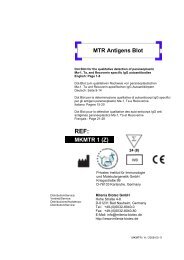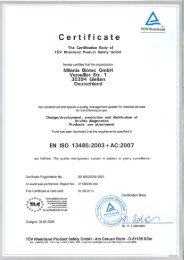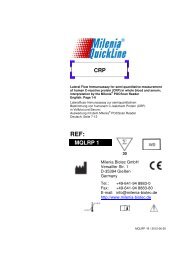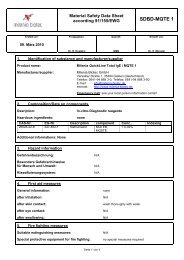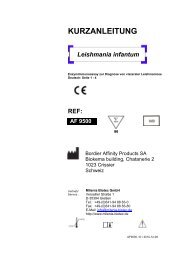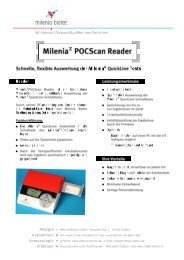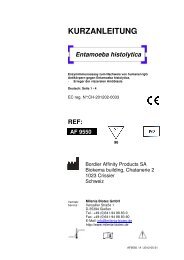OPA IgG Blot - Milenia Biotec GmbH
OPA IgG Blot - Milenia Biotec GmbH
OPA IgG Blot - Milenia Biotec GmbH
You also want an ePaper? Increase the reach of your titles
YUMPU automatically turns print PDFs into web optimized ePapers that Google loves.
<strong>OPA</strong> <strong>IgG</strong> <strong>Blot</strong><br />
Dot <strong>Blot</strong> for the qualitative detection of<br />
onconeural/paraneoplastic amphiphysine I, Yo, Ri, HuD,<br />
Ma-1, Ta and recoverine specific <strong>IgG</strong> autoantibodies<br />
English: Page 1-8<br />
Dot-<strong>Blot</strong> zum qualitativen Nachweis von<br />
onkoneuralen/paraneoplastischen Amphiphysin I, Yo, Ri, HuD,<br />
Ma-1, Ta und Recoverin spezifischen <strong>IgG</strong> Autoantikörpern<br />
Deutsch: Seite 14<br />
Dot <strong>Blot</strong> pour la détection qualitative des auto-anticorps (<strong>IgG</strong>)<br />
anti-onconeuronaux/paranéoplastiques amphiphysine I, Yo, Ri,<br />
HuD, Ma-1, Ta et recoverine<br />
Français : Page 15-21<br />
REF:<br />
MK<strong>OPA</strong> 1 (Z)<br />
24 (8)<br />
Manufacturer: Privates Institut für Immunologie<br />
Hersteller:<br />
und Molekulargenetik <strong>GmbH</strong><br />
Fabricant: Kriegsstraße 99<br />
D-76133 Karlsruhe, Germany<br />
Telefon: +49 (721) 85 000 – 0<br />
Telefax: +49 (721) 85 000 115<br />
http://www.laborseelig.de<br />
Distribution/Service: <strong>Milenia</strong> <strong>Biotec</strong> <strong>GmbH</strong><br />
Vertrieb/Service: Versailler Str. 1<br />
Distribution/Service: 35394 Gießen, Germany<br />
Telefon: +49 (641) 948883 – 0<br />
Telefax: +49 (641) 948883 – 80<br />
E-mail: info@milenia-biotec.de<br />
http://www.milenia-biotec.de<br />
MK<strong>OPA</strong> / A / 2010-02-18
- 2 -<br />
Explanation of Symbols<br />
Symbols (GB) / Symbole (D) / Symboles (F)<br />
REF<br />
Explanation / Erklärung / Signification<br />
Expiry date<br />
Haltbarkeitsdatum<br />
Date de péremption<br />
In Vitro Diagnostic Medical Device<br />
In Vitro Diagnostikum<br />
Diagnostic in vitro<br />
Batch code<br />
Los-Bezeichnung<br />
Lote<br />
Catalogue number<br />
Artikel-Nummer<br />
Référence<br />
Storage conditions<br />
Lagerungsbedingungen<br />
Température de conservation<br />
Consult Instructions for Use<br />
Gebrauchsanweisung beachten<br />
Consulter la notice<br />
Consult attended documents<br />
Begleitdokumente beachten<br />
Consulter le document avec attention<br />
Package size<br />
Packungsgröße<br />
Nombre de tests par trousse<br />
Manufacturer<br />
Hersteller<br />
Fabriqué par<br />
Only for evaluation purposes<br />
Nur zur Leistungsbewertung<br />
Pour évaluation uniquement<br />
<strong>OPA</strong> <strong>IgG</strong> <strong>Blot</strong> (MK<strong>OPA</strong>)
- 3 -<br />
Materials Supplied, Storage and Stability<br />
Components Cat.-No. Content Preparation Store at Shelf life<br />
<strong>OPA</strong> Dotblot Strips,<br />
nitrocellulose strips coated<br />
with recombinant<br />
onconeural/paraneoplastic<br />
antigens Amphiphysin I, Yo,<br />
Ri, HuD, Ma-1, Ta and<br />
Recoverine<br />
<strong>OPA</strong> Control Sera,<br />
negative control<br />
positive control<br />
<strong>OPA</strong> Enzyme Conjugate,<br />
polyclonal (goat) anti-hu-<strong>IgG</strong><br />
antibodies, labeled with<br />
alkaline phosphatase<br />
<strong>OPA</strong> Buffered Wash<br />
Solution, Concentrate (5x)<br />
Substrate Solution,<br />
contains 5-Brom-4-chloro-3-<br />
indolyl phosphate and 4-Nitrobluetetrazoliumchloride<br />
M<strong>OPA</strong>DS 24 (8) ready to use 2 - 8 °C<br />
Protect from<br />
moisture!<br />
Store together<br />
with desiccant<br />
in the tube!<br />
Do not touch<br />
with fingers!<br />
M<strong>OPA</strong>C1/2 1 set<br />
2 vials à<br />
100 (30)<br />
µL<br />
ME<strong>OPA</strong> 2 (1)<br />
vial(s)<br />
à 15 mL<br />
MWB<strong>OPA</strong><br />
1 vial<br />
50 mL<br />
MS<strong>OPA</strong> 2 (1)<br />
vial(s)<br />
à 15 mL<br />
Disposable incubation trays M<strong>OPA</strong>P 3 (1)<br />
Evaluation Sheet <strong>OPA</strong>A 1 (1)<br />
see expiry<br />
date<br />
ready to use 2 – 8 °C see expiry<br />
date<br />
ready to use 2 - 8 °C see expiry<br />
date<br />
Dilute before<br />
use: e.g. add to<br />
10 mL 5 x wash<br />
buffer to 40 mL<br />
dest. water<br />
ready to use 2 - 8 °C<br />
Protect from<br />
light!<br />
2 - 8 °C 30 days after<br />
opening, 5<br />
days after<br />
dilution<br />
Material Safety Data Sheets are available on request (see also www.milenia-biotec.de).<br />
30 days after<br />
opening, resp.<br />
until the<br />
expiry date<br />
Materials Required<br />
• horizontal Shaker<br />
• vortex mixer<br />
• destilled water<br />
• graduated cylinder for 250 mL; storage flasks for the wash buffer<br />
• pipettes for 10, 50 and 1000 µL<br />
• reaction tubes for predilution of the samples<br />
• optional: Westernblot Processor<br />
<strong>OPA</strong> <strong>IgG</strong> <strong>Blot</strong> (MK<strong>OPA</strong>)
- 4 -<br />
Specimen Collection and Preparation<br />
Serum, plasma (EDTA, citrated, heparinized) and cerebrospinal fluid (CSF) can be used as sample<br />
materials. All serum/plasma samples and controls provided with the kit should be diluted 1:100 with<br />
wash buffer; e.g. 10 µL sample is mixed with 990 µL wash buffer, in order to give final dilution of<br />
1:100.<br />
During transportation, patient samples may be stored at room temperature for up to 24 hours. For<br />
short term storage the samples can be stored at 2-8 °C for up to 5 days. For long term storage the<br />
samples should be dispensed and stored frozen at < -18°C. Avoid repeated freeze-thaw cycles.<br />
Warnings and Precautions<br />
All reagents of this test kit are strictly intended for in vitro diagnostic use only. This test should be<br />
carried out only by persons who are familiar in performing in vitro diagnostic procedures. Please follow<br />
strictly the sequence of pipetting steps provided in this protocol.<br />
All control samples included in the kit are tested for HCV, HIV1,2 and HbS antigen by a CE marked kit<br />
and found to be negative. However a 100% garantee to be negative can not be given. Therefore all<br />
control samples and all patient samples should be handled as potentially infectious in a laminar flow<br />
clean bench.<br />
Method and Test Principle<br />
The <strong>OPA</strong> <strong>IgG</strong> <strong>Blot</strong> is an immunoassay in a dot blot format for the qualitative detection of human <strong>IgG</strong><br />
autoantibodies against the onconeuronal/paraneoplastic antigens amphiphysine I, Yo, Ri, HuD, Ma-1,<br />
Ta and recoverine. Human recombinant proteins amphiphysine I, Yo, Ri, HuD, Ma-1, Ta and<br />
recoverine are immobilized on fixed locations of a nitrocellulose membrane; in addition anti-human<br />
<strong>IgG</strong> antibodies are immobilized as functional control.<br />
The ready to use sample is pipetted to the prewetted antigen coated carrier membrane. During the<br />
first incubation period the autoantibodies present in the patient’s samples will bind according to their<br />
antigen specificity. In the following step unbound serum components are washed away. Bound<br />
immune complexes are labelled with alkaline phosphatase conjugated anti-human <strong>IgG</strong> during the next<br />
incubation period. Surplus of conjugate is removed by washing the strips. Finally, immunocomplexes<br />
are visualized by the addition of the colorless enzym substrate BCIP/NBT which forms a blue<br />
precipitate line. Type of antibodies in the sample are then identified by comparing their position with<br />
the reference bands on the evaluation sheet.<br />
<strong>OPA</strong> <strong>IgG</strong> <strong>Blot</strong> (MK<strong>OPA</strong>)
- 5 -<br />
Test Performance<br />
Important notes:<br />
• Do not interchange components of different lots and assays.<br />
• Do not use kit components beyond their expiration dates.<br />
• All components should be prewarmed at room temperature (18 – 28 °C) before use.<br />
• Dilute concentrates at least 30 minutes prior to use. Mix well, but prevent foam formation.<br />
• To avoid carryover contamination carefully aspirate fluids; take particularly care on patient sample<br />
containing fluids!<br />
1. Using tweezers, place the required number<br />
of strips in the incubation tray (labeling<br />
must face up).<br />
2. Overlay the strips with 990 µl wash buffer<br />
(500 µl for CSF) and incubate for 5<br />
minutes at room temperature (18-28 °C) on<br />
a shaker. Do not aspirate; wash buffer<br />
remains in the reservoirs !<br />
3. Add 10 µl patient serum/plasma (undiluted)<br />
and controls (undiluted) or 500 µl<br />
cerebrospinal fluid (undiluted).<br />
Incubate for 90 minutes on shaker.<br />
4. Aspirate and wash the strips with 1000 µL wash buffer. Do it by carefully mixing and aspiration.<br />
5. Add 1000 µL of wash buffer and shake for 5 minutes. Aspirate the wash buffer. Repeat this<br />
step once.<br />
6. Pipet 1000 µL Enzyme Conjugate solution and incubate for 60 minutes on a shaker.<br />
7. Aspirate and wash the strips with 1000 µL wash buffer. Do it by carefully mixing and aspiration.<br />
8. Add 1000 µL of wash buffer and shake for 5 minutes. Aspirate fluid. Repeat this step once.<br />
9. Pipet 1000 µL of Substrate Solution and incubate 5-15 minutes on a shaker. Control the color<br />
development after 5 minutes. The functional control should be a clearly visible band on all<br />
strips. Especially the positive control should show eight clearly visible bands.<br />
10. Aspirate Substrate Solution and wash twice with 1000 µL of distilled water.<br />
11. Remove the strips from their reservoir using tweezers. Airdry on adsorbent paper for about 30<br />
minutes.<br />
12. Interpret the band pattern according the evaluation sheet provided with the kit.<br />
<strong>OPA</strong> <strong>IgG</strong> <strong>Blot</strong> (MK<strong>OPA</strong>)
- 6 -<br />
Interpretation of Results<br />
After complete drying, the strips will be placed according their functional control on the evaluation<br />
sheet (see interpretation sample) with the numbers on top and the ends of the strips fixed with<br />
adhesive film. The position of the antigen bands may slightly vary from lot to lot, but they always lay<br />
within the indicated marks of the evaluation sheet. The blue color of the antigen bands will fade, if the<br />
dry strips are exposed to air and light for a longer time.<br />
M: marker for position of antigens.<br />
1. negative control<br />
2. positive control<br />
3 - 8. example of patient sera.<br />
Antigen M 1 2 3 4 5 6 7 8<br />
Amphiphysine I<br />
Yo<br />
Ri<br />
HuD<br />
Ma<br />
Ta<br />
Recoverine<br />
Functional Control<br />
Test results are interpreted by comparing locations and color intensities of the bands with those of the<br />
control supplied with the kit.<br />
Positive Result Negative Result Borderline<br />
only samples with a stronger or similar no bands or very weak lower intensities than that of<br />
color intensity as the signal obtained with bands are interpreted as the positive control but more<br />
the positive control from the kit are clearly negative<br />
intensive than that of the<br />
positive<br />
negative control are<br />
borderline<br />
In principle, the results of this immuno dot blot should be interpreted for diagnosis only in context with<br />
the patient´s clinical state of health and other diagnostic and epidemiologic data.<br />
<strong>OPA</strong> <strong>IgG</strong> <strong>Blot</strong> (MK<strong>OPA</strong>)
- 7 -<br />
Quality Control<br />
The functional control on each strip (internal reaction control) has to display an intensive color. The<br />
negative control must show only the functional control band; in very rare cases very faint bands can be<br />
seen, which have no importance.<br />
The positive control must always show an intensive staining of the seven antigens (amphiphysine I,<br />
Yo, Ri, HuD, Ma-1, Ta and recoverine) and the functional control; if not, the test has to be repeated.<br />
Assay Characteristics<br />
Sample material:<br />
Time for test procedure:<br />
Specificity:<br />
serum, plasma, cerebrospinal fluid<br />
3.5 hours<br />
by probing 100 healthy blood donors none tested serum was found to be<br />
positive.<br />
<strong>OPA</strong> <strong>IgG</strong> <strong>Blot</strong> (MK<strong>OPA</strong>)
- 8 -<br />
Short Instruction: <strong>OPA</strong> <strong>IgG</strong> <strong>Blot</strong><br />
(all sample volumes are given in µL)<br />
Steps Solution Sample Controls:<br />
negative/positive<br />
Pipet to the strips Wash Buffer 990 µl<br />
Incubate for 5 min at room temperature<br />
(18-28 °C) on a shaker; do not aspirate<br />
the solution!<br />
Add<br />
control<br />
(undiluted)<br />
(500 µl<br />
for CSF)<br />
990 µl<br />
- 10 µl<br />
Add<br />
sample<br />
(undiluted)<br />
10 µl -<br />
or add CSF(undiluted) 500 µl -<br />
Incubate for 90 min at RT on a shaker<br />
Aspirate; wash the strips with 1000 µl<br />
wash buffer by mixing gently and aspirate<br />
again<br />
Add 1000 µl of wash buffer to each strip<br />
and incubate for 5 min at RT on a shaker;<br />
aspirate<br />
Repeat this step once<br />
Add<br />
Incubate for 60 min at RT on a shaker<br />
Aspirate; wash the strips with 1000 µl<br />
wash buffer by mixing gently and aspirate<br />
again<br />
Add 1000 µl of wash buffer to each strip<br />
and incubate for 5 min at RT on a shaker;<br />
aspirate<br />
Repeat this step once<br />
Add<br />
Incubate for 5 – 15 min at RT on a shaker<br />
Decant and wash the strips twice with<br />
1000 µl destilled water<br />
Remove the strips with tweezers and airdry<br />
on adsorbent paper for about 30 min<br />
Analyze the band pattern using the<br />
evaluation sheet<br />
Enzyme<br />
Conjugate<br />
Substrate<br />
Solution<br />
1000 µl 1000 µl<br />
1000 µl 1000 µl<br />
For a detailed description of the procedure see also page 5.<br />
<strong>OPA</strong> <strong>IgG</strong> <strong>Blot</strong> (MK<strong>OPA</strong>)
- 9 -<br />
<strong>OPA</strong> <strong>IgG</strong> <strong>Blot</strong><br />
Dot <strong>Blot</strong> for the qualitative detection of onconeural/<br />
paraneoplastic amphiphysine I, Yo, Ri, HuD, Ma-1, Ta and<br />
recoverine specific <strong>IgG</strong> autoantibodies<br />
English: Page 1-8<br />
Dot-<strong>Blot</strong> zum qualitativen Nachweis von onkoneuralen/<br />
paraneoplastischen Amphiphysin I, Yo, Ri, HuD, Ma-1, Ta<br />
und Recoverin spezifischen <strong>IgG</strong> Autoantikörpern<br />
Deutsch: Seite 14<br />
Dot <strong>Blot</strong> pour la détection qualitative des auto-anticorps (<strong>IgG</strong>)<br />
anti-onconeuronaux/paranéoplastiques amphiphysine I, Yo, Ri,<br />
HuD, Ma-1, Ta et recoverine<br />
Français : Page 15-21<br />
REF:<br />
MK<strong>OPA</strong> 1 (Z)<br />
24 (8)<br />
Manufacturer: Privates Institut für Immunologie<br />
Hersteller:<br />
und Molekulargenetik <strong>GmbH</strong><br />
Fabricant: Kriegsstraße 99<br />
D-76133 Karlsruhe, Germany<br />
Telefon: +49 (721) 85 000 – 0<br />
Telefax: +49 (721) 85 000 115<br />
http://www.laborseelig.de<br />
Distribution/Service: <strong>Milenia</strong> <strong>Biotec</strong> <strong>GmbH</strong><br />
Vertrieb/Service: Versailler Str. 1<br />
Distribution/Service: 35394 Gießen, Germany<br />
Telefon: +49 (641) 948883 – 0<br />
Telefax: +49 (641) 948883 – 80<br />
E-mail: info@milenia-biotec.de<br />
http://www.milenia-biotec.de<br />
<strong>OPA</strong> <strong>IgG</strong> <strong>Blot</strong> (MK<strong>OPA</strong>)
- 10 -<br />
Kitbestandteile, Lagerung und Stabilität<br />
Komponente Art.-Nr. Inhalt Vorbereitung Lagerung bei Haltbarkeit<br />
<strong>OPA</strong> Dot-<strong>Blot</strong> Streifen<br />
(<strong>OPA</strong> Dotblot Strips),<br />
Nitrozellulose-Streifen<br />
beschichtet mit<br />
rekombinanten<br />
onkoneuralen/<br />
paraneoplastischen<br />
Antigenen Amphiphysin I,<br />
Yo, Ri, HuD, Ma-1, Ta und<br />
Recoverin<br />
M<strong>OPA</strong>DS 24 (8) gebrauchsfertig 2 - 8 °C<br />
Vor<br />
Feuchtigkeit<br />
schützen!<br />
Zusammen mit<br />
Trocknungsmittel<br />
in dem Röhrchen<br />
aufbewahren<br />
Nicht mit den<br />
Fingern<br />
anfassen!<br />
bis zum<br />
Verfallsdatum<br />
<strong>OPA</strong> Kontroll-Sera<br />
(<strong>OPA</strong> Control Serum),<br />
Negativkontrolle<br />
Positivkontrolle<br />
M<strong>OPA</strong>C1/<br />
2/<br />
1 Set<br />
2 Fl. à<br />
100 (30) µl<br />
gebrauchsfertig 2 – 8 °C bis zum<br />
Verfallsdatum<br />
<strong>OPA</strong> Enzym-Konjugat<br />
(<strong>OPA</strong> Enzyme Conjugate),<br />
polyklonaler (Ziegen) antihu-<strong>IgG</strong><br />
Antikörper, markiert<br />
mit alkalischer<br />
Phosphatase<br />
<strong>OPA</strong> Waschpuffer<br />
(<strong>OPA</strong> Buffered Wash<br />
Solution),<br />
Konzentrat (5x)<br />
Substrat-Lösung<br />
(Substrate Solution),<br />
enthält 5-Brom-4-Chlor-3-<br />
Indolyl-Phosphat und 4-<br />
Nitro-Blautetrazoliumchlorid<br />
ME<strong>OPA</strong><br />
MWB<strong>OPA</strong><br />
MS<strong>OPA</strong><br />
2 (1) Fl.<br />
à 15 ml<br />
1 Fl.<br />
50 ml<br />
2 (1) Fl.<br />
à 15 ml<br />
Einweg-Inkubationswannen M<strong>OPA</strong>P 3 (1)<br />
Auswertebogen <strong>OPA</strong>A 1 (1)<br />
gebrauchsfertig 2 - 8 °C bis zum<br />
Verfallsdatum<br />
Vor Gebrauch<br />
verdünnen: z.B.<br />
zu 10 ml<br />
Waschpuffer-<br />
Konzentrat<br />
40 ml dest.<br />
Wasser<br />
zugeben<br />
gebrauchsfertig 2 - 8 °C<br />
Vor Licht<br />
schützen!<br />
2 - 8 °C 30 Tage nach<br />
dem Öffnen, 5<br />
Tage nach<br />
dem<br />
Verdünnen,<br />
bzw. bis zum<br />
Verfallsdatum<br />
30 Tage nach<br />
dem Öffnen<br />
bzw. bis zum<br />
Verfallsdatum<br />
Sicherheitsdatenblätter sind auf Anfrage erhältlich (siehe auch unter www.milenia-biotec.de).<br />
Erforderliche Hilfsmittel<br />
• Horizontal-Schüttler<br />
• Wirbelmischer (Vortex)<br />
• destilliertes Wasser<br />
• Messzylinder für 250 ml; Plastikgefäße zur Aufbewahrung des Waschpuffers<br />
• Mikropipetten für 10, 50 und 1000 µl<br />
• Reaktionsgefäße zur Probenverdünnung<br />
• Optional: Westernblot Prozessor<br />
<strong>OPA</strong> <strong>IgG</strong> <strong>Blot</strong> (MK<strong>OPA</strong>)
- 11 -<br />
Probenentnahme und -vorbereitung<br />
Als Probenmaterial können Serum, Plasma (EDTA, Citrat, Heparin) und Liquor cerebrospinalis<br />
verwendet werden. Alle Serum-/Plasmaproben und die im Kit befindlichen Kontrollen werden 1:100<br />
mit Waschpuffer verdünnt; dazu wird beispielsweise 10 µl Probe zu 990 µl Wasch-Puffer gegeben,<br />
was eine Endverdünnung der Probe von 1:100 ergibt. Liquor kann unverdünnt eingesetzt werden.<br />
Für den Transport kann das Untersuchungsmaterial bis zu 24 Stunden bei Raumtemperatur gelagert<br />
werden. Die Proben können gekühlt bei 2-8 °C bis zu 5 Tage aufbewahrt werden. Ist eine längere<br />
Lagerung beabsichtigt, sollten die Proben aliquotiert und bei < -18 °C tiefgefroren werden. Wiederholte<br />
Einfrier- und Auftauzyklen sind zu vermeiden.<br />
Hinweise und Vorsichtsmassnahmen<br />
Alle Reagenzien dieser Testpackung dürfen ausschließlich zur in vitro-Diagnostik verwendet werden.<br />
Die Anwendung sollte durch Personal erfolgen, das speziell in Verfahren von in vitro-Diagnostika<br />
unterrichtet und ausgebildet wurde. Die Einhaltung des vorgeschriebenen Protokolls zur Durchführung<br />
des Tests ist unbedingt erforderlich.<br />
Alle im Kit enthaltenen Kontrollseren wurden auf HCV, HIV1,2 and HbS Antigen getestet und für<br />
negativ befundet. Da aber ein hundertprozentige Sicherheit nicht garantriert werden kann, sind alle im<br />
Kit enthaltenen Seren sowie das Untersuchungsmaterial von Patienten stets als potentiell infektiös<br />
einzustufen und sollten stets in einer Sicherheitswerkbank weiterbearbeitet werden.<br />
Methodik und Testprinzip<br />
Der <strong>OPA</strong> <strong>IgG</strong> <strong>Blot</strong> Test ist ein Immunoassay im Dot-<strong>Blot</strong>-Verfahren zur qualitativen Bestimmung von<br />
humanen <strong>IgG</strong>-Autoantikörpern gegen die neuronalen/paraneoplastischen Antigene Amphiphysin I, Yo,<br />
Ri, HuD, Ma-1, Ta und Recoverin. Die rekombinanten humanen Proteine Amphiphysin I, Yo, Ri, HuD,<br />
Ma-1, Ta und Recoverin sind auf einer Nitrozellulose-Membran an fixen Stellen aufgetragen;<br />
zusätzlich sind anti-human-<strong>IgG</strong>-Antikörper als Funktionskontrolle aufgetragen.<br />
Die Patientenprobe wird zu der Antigen-beladenen Trägermembran pipettiert. Während der ersten<br />
Inkubation binden die in der Patientenprobe vorhandenen Autoantikörper entsprechend ihrer Antigen-<br />
Spezifität. Im nächsten Schritt werden ungebundene Serumbestandteile weggewaschen. Während der<br />
nächsten Inkubation werden die gebundenen Immunkomplexe mit anti-human-<strong>IgG</strong>, das mit alkalischer<br />
Phosphatase konjugiert ist, markiert. Überschüssiges Konjugat wird durch Waschen der Streifen<br />
entfernt. Schließlich werden die Immunkomplexe sichtbar gemacht, indem sich durch Zugabe von<br />
farblosem Enzymsubstrat (BCIP/NBT) eine blaue Präzipitat-Linie bildet. Die Antikörper-Typen der<br />
Probe werden durch den Vergleich der Positionen mit denen der Referenzbanden auf der<br />
Auswerteschablone identifiziert.<br />
<strong>OPA</strong> <strong>IgG</strong> <strong>Blot</strong> (MK<strong>OPA</strong>)
- 12 -<br />
Testdurchführung<br />
Wichtige Hinweise<br />
• Einzelne Komponenten verschiedener Chargen und Testbestecke dürfen nicht ausgetauscht<br />
werden.<br />
• Kitbestandteile dürfen nach Ablauf des Haltbarkeitsdatums nicht benutzt werden.<br />
• Alle Komponenten müssen vor Gebrauch auf Raumtemperatur (18-28 °C) erwärmt werden.<br />
• Die Konzentrate müssen mindestens 30 Minuten vor Gebrauch verdünnt werden. Gut mischen,<br />
Schaumbildung vermeiden.<br />
• Um Kreuzkontaminationen zu vermeiden Flüssigkeiten vorsichtig absaugen; das gilt vor allem für<br />
die Patientenproben-haltigen Flüssigkeiten!<br />
1. Mit einer Pinzette die benötigte Anzahl an<br />
Streifen in die Inkubationswannen legen<br />
(Beschriftung nach oben).<br />
2. Streifen mit 990 µl Waschpuffer (500 µl für<br />
Liquor) überschichten und 5 Minuten bei<br />
Raumtemperatur (18-28 °C) auf einem Schüttler<br />
inkubieren. Nicht Absaugen, Waschpuffer<br />
verbleibt in den Reservoirs!<br />
3. 10 µl Serum/Plasma (unverdünnt) und<br />
Kontrollen (unverdünnt) oder 500 µl Liquor<br />
(unverdünnt) zugeben.<br />
90 Minuten auf einem Schüttler inkubieren.<br />
4. Absaugen und die Streifen mit 1000 µl Waschpuffer waschen. Dabei vorsichtig schwenken und<br />
dann wieder absaugen.<br />
5. 1000 µl Waschpuffer hinzugeben, 5 Minuten schütteln. Waschpuffer absaugen. Diesen Schritt<br />
einmal wiederholen.<br />
6. 1000 µl Enzymkonjugat-Lösung zupipettieren und 60 Minuten auf einem Schüttler inkubieren.<br />
7. Absaugen und die Streifen mit 1000 µl Waschpuffer waschen. Dabei vorsichtig schwenken und<br />
dann wieder absaugen.<br />
8. 1000 µl Waschpuffer hinzugeben, 5 Minuten schütteln. Waschpuffer absaugen. Diesen Schritt<br />
einmal wiederholen.<br />
9. 1000 µl Substrat-Lösung zupipettieren und 5 - 15 Minuten unter Schütteln inkubieren. Nach<br />
5 Minuten die Farbentwicklung kontrollieren. Die Funktionskontrolle sollte auf allen Streifen als<br />
intensive Bande sichtbar sein. Insbesondere soll die Positivkontrolle acht deutlich sichtbare<br />
Banden aufweisen.<br />
10. Substratlösung absaugen und Streifen zweimal mit 1000 µl dest. Wasser waschen.<br />
11. Streifen mit einer Pinzette der Wanne entnehmen und für ca. 30 Minuten auf Filterpapier<br />
lufttrocknen.<br />
12. Das Bandenmuster mit dem im Kit vorhandenen Auswertebogen interpretieren.<br />
<strong>OPA</strong> <strong>IgG</strong> <strong>Blot</strong> (MK<strong>OPA</strong>)
- 13 -<br />
Auswertung der Ergebnissse<br />
Die komplett getrockneten Streifen werden anhand der Funktionskontrolle auf dem Auswertebogen<br />
(siehe Auswertebeispiel) mit der Nummerierung nach oben ausgerichtet und mit Tesafilm an ihren<br />
Enden befestigt. Die Position der Antigene auf den Streifen kann chargenabhängig geringgradig<br />
variieren, sie liegen aber stets in dem Bereich der auf dem Auswertebogen befindlichen<br />
Markierungen. Die blaue Färbung der Antigen-Banden verblaßt, wenn die trockenen Streifen Luft und<br />
Licht für längere Zeit ausgesetzt sind.<br />
M: Positionsmarker der Antigene<br />
Antigen M 1 2 3 4 5 6 7 8<br />
1. Negativ-Kontrollserum<br />
2. Positiv-Kontrollserum<br />
3 - 8. Beispiele für Patientenseren<br />
Amphiphysin I<br />
Yo<br />
Ri<br />
HuD<br />
Ma<br />
Ta<br />
Recoverin<br />
Funktions Kontrolle<br />
Die Testergebnisse werden anhand von Lokalisation und Farbintensität der Banden mit den Kontrollen<br />
aus dem Kit verglichen und entsprechend ausgewertet.<br />
Positives Ergebnis Negatives Ergebnis Grenzwertig<br />
Nur Proben mit einer kräftigen oder Keine oder ganz schwache Geringere Intensitäten als die<br />
ähnlichen Bandenintensität wie die der Banden sind als negativ zu der Positivkontrolle, aber<br />
Positivkontrolle sind eindeutig Antikörperpositiv!<br />
Negativkontrolle, sind als<br />
interpretieren<br />
intensivere als die der<br />
grenzwertig zu interpretieren<br />
Prinzipiell sollten die Ergebnisse des Immunoblots zur Diagnosestellung nur im Zusammenhang mit<br />
dem klinischen Bild und anderen diagnostischen und epidemiologischen Daten interpretiert werden.<br />
Qualitätskontrolle<br />
Die auf jedem Streifen vorhandene Funktionskontrolle (interne Reaktionskontrolle) muß kräftig gefärbt<br />
sein. Die Negativ-Kontrolle darf nur die Färbung der Funktionskontrolle aufweisen; in wenigen<br />
seltenen Fällen treten sehr schwache Banden auf, denen keine Bedeutung zukommt.<br />
Die Positiv-Kontrolle muß immer eine kräftige Färbung der sieben Antigene (Amphiphysin I, Yo, Ri,<br />
HuD, Ma-1, Ta und Recoverin) und der Funktionskontrolle zeigen; falls nicht, muß der Test wiederholt<br />
werden.<br />
Testcharakteristika<br />
Probenmaterial:<br />
Zeit zur Testdurchführung:<br />
Spezifität:<br />
Serum, Plasma, Liquor<br />
3,5 Stunden<br />
Bei der Testung von 100 gesunden Blutspendern wurde für keines der<br />
untersuchten Seren ein positives Ergebnis gefunden<br />
<strong>OPA</strong> <strong>IgG</strong> <strong>Blot</strong> (MK<strong>OPA</strong>)
- 14 -<br />
Kurzanleitung: <strong>OPA</strong> <strong>IgG</strong> <strong>Blot</strong><br />
(alle Volumenangaben in µl)<br />
Schritte Lösung Probe Kontrolle<br />
negativ/positiv<br />
Zu den Streifen pipettieren Waschpuffer 990 µl<br />
5 min bei Raumtemperatur (18-28 °C) auf<br />
einem Schüttler inkubieren;<br />
die Lösungen nicht absaugen!<br />
(500 µl<br />
für<br />
Liquor)<br />
990 µl<br />
Zugeben Kontrolle - 10 µl<br />
Zugeben<br />
90 min bei Raumtemperatur (RT) auf einem<br />
Schüttler inkubieren<br />
Absaugen; die Streifen mit 1000 µl<br />
Waschpuffer durch vorsichtiges Mischen<br />
waschen und wieder absaugen<br />
1000 µl Waschpuffer zu jedem Streifen<br />
zugeben und für 5 min bei RT auf einem<br />
Schüttler inkubieren; absaugen<br />
Diesen Schritt einmal wiederholen<br />
Zugeben<br />
60 min bei RT auf einem Schüttler<br />
inkubieren<br />
Absaugen; die Streifen mit 1000 µl<br />
Waschpuffer durch vorsichtiges Mischen<br />
waschen und wieder absaugen<br />
1000 µl Waschpuffer zu jedem Streifen<br />
zugeben und für 5 min bei RT auf einem<br />
Schüttler inkubieren; absaugen<br />
Diesen Schritt einmal wiederholen<br />
Zugeben<br />
5 – 15 min bei RT auf einem Schüttler<br />
inkubieren<br />
Absaugen und zweimal mit 1000 µl dest.<br />
Wasser waschen<br />
Die Streifen mit einer Pinzette entfernen und<br />
auf einem Papier ca. 30 min lufttrocknen<br />
lassen<br />
Die Bandenmuster anhand des<br />
Auswertebogens analysieren<br />
unverdünnte<br />
Probe<br />
(Liquor<br />
unverdünnt)<br />
Enzym-<br />
Konjugat<br />
Substrat-<br />
Lösung<br />
10 µl<br />
(500 µl)<br />
1000 µl 1000 µl<br />
1000 µl 1000 µl<br />
Vgl. auch Seite 2-13 für eine detaillierte Beschreibung der Testdurchführung.<br />
-<br />
<strong>OPA</strong> <strong>IgG</strong> <strong>Blot</strong> (MK<strong>OPA</strong>)
- 15 -<br />
<strong>OPA</strong> <strong>IgG</strong> <strong>Blot</strong><br />
Dot <strong>Blot</strong> for the qualitative detection of<br />
onconeural/paraneoplastic Amphiphysin I, Yo, Ri, HuD, Ma-1,<br />
Ta and Recoverin specific <strong>IgG</strong> autoantibodies<br />
English: Page 1-8<br />
Dot-<strong>Blot</strong> zum qualitativen Nachweis von<br />
onkoneuralen/paraneoplastischen Amphiphysin I, Yo, Ri, HuD,<br />
Ma-1, Ta und Recoverin spezifischen <strong>IgG</strong> Autoantikörpern<br />
Deutsch: Seite 9-14<br />
Dot <strong>Blot</strong> pour la détection qualitative des auto-anticorps<br />
(<strong>IgG</strong>) anti-onconeuronaux/paranéoplastiques<br />
amphiphysine I, Yo, Ri, HuD, Ma-1, Ta et recoverine<br />
Français : Page 15-21<br />
REF:<br />
MK<strong>OPA</strong> 1 (Z)<br />
24 (8)<br />
Manufacturer: Privates Institut für Immunologie<br />
Hersteller:<br />
und Molekulargenetik <strong>GmbH</strong><br />
Fabricant: Kriegsstraße 99<br />
D-76133 Karlsruhe, Germany<br />
Telefon: +49 (721) 85 000 – 0<br />
Telefax: +49 (721) 85 000 115<br />
http://www.laborseelig.de<br />
Distribution/Service: <strong>Milenia</strong> <strong>Biotec</strong> <strong>GmbH</strong><br />
Vertrieb/Service: Versailler Str. 1<br />
Distribution/Service: 35394 Gießen, Germany<br />
Telefon: +49 (641) 948883 – 0<br />
Telefax: +49 (641) 948883 – 80<br />
E-mail: info@milenia-biotec.de<br />
http://www.milenia-biotec.de<br />
<strong>OPA</strong> <strong>IgG</strong> <strong>Blot</strong> (MK<strong>OPA</strong>)
- 16 -<br />
Contenu du kit, stockage et stabilité<br />
Composants Cat.-No. Quantité Préparation Conservatio Durée de vie<br />
Bandelettes Dotblot <strong>OPA</strong><br />
(<strong>OPA</strong> Dotblot Strips),<br />
Bandelettes de nitrocellulose<br />
coatées avec des antigènes<br />
onco-neuronaux/paranéoplastiques<br />
recombinants<br />
amphiphysine I, Yo, Ri,<br />
HuD, Ma-1, Ta et<br />
recoverine<br />
Sérum de contrôle <strong>OPA</strong><br />
(<strong>OPA</strong> Control Serum),<br />
contrôle négatif<br />
contrôle positif<br />
Conjugué enzymatique <strong>OPA</strong><br />
(<strong>OPA</strong> Enzyme Conjugate),<br />
Anticorps polyclonal (de<br />
chèvre) anti <strong>IgG</strong> humaines,<br />
couplé à de la phosphatase<br />
alcaline<br />
Solution de lavage <strong>OPA</strong><br />
(<strong>OPA</strong> Buffered Wash<br />
Solution),<br />
Concentrée (5x)<br />
Solution de substrat<br />
(Substrate Solution),<br />
Substrat: 5-bromo-4-chloro-3-<br />
indolyl phosphate (BCIP) et<br />
nitrobleu de tétrazolium (NBT)<br />
M<strong>OPA</strong>DS 24 (8) Prêt à l’emploi 2 - 8 °C<br />
Protéger de<br />
l’humidité !<br />
Stocker avec<br />
du dessicant !<br />
Ne pas<br />
toucher avec<br />
les doigts!<br />
M<strong>OPA</strong>C1/<br />
2/<br />
1 jeu de<br />
2 flacons de<br />
100 µl (30)<br />
chacun<br />
ME<strong>OPA</strong> 2 (1)<br />
flacon(s)<br />
de 15 ml<br />
chacun<br />
MWB<strong>OPA</strong> 1 flacon<br />
de 50 ml<br />
MS<strong>OPA</strong> 2 (1)<br />
flacon(s)<br />
de 15 ml<br />
chacun<br />
Plateau d’incubation M<strong>OPA</strong>P 3 (1)<br />
Fiche d’évaluation <strong>OPA</strong>A 1 (1)<br />
Voir date de<br />
péremption<br />
Prêt à l’emploi 2 – 8 °C Voir date de<br />
péremption<br />
Prêt à l’emploi 2 - 8 °C Voir date de<br />
péremption<br />
Diluer avant<br />
usage : 10 ml de<br />
solution de lavage<br />
concentrée dans<br />
40 ml d’eau<br />
distillée<br />
Prêt à l’emploi 2 - 8 °C<br />
Protéger de la<br />
lumière !<br />
2 - 8 °C 30 jours après<br />
ouverture, 5<br />
jours après<br />
dilution ou<br />
jusqu'à la date<br />
de péremption<br />
30 jours après<br />
ouverture ou<br />
jusqu'à la date<br />
de péremption<br />
Les fiches de sécurité sont disponibles sur demande (voir également sur www.milenia-biotec.de).<br />
Matériel requis<br />
• Agitateur horizontal<br />
• Vortex<br />
• Eau distillée<br />
• Eprouvette graduée de 250 ml; flacon pour stocker la solution de lavage<br />
• Pipettes de 10, 50 et 1000 µl<br />
• Tubes à essais pour la prédilution des échantillons<br />
• Optionnel: automate de western-blot<br />
<strong>OPA</strong> <strong>IgG</strong> <strong>Blot</strong> (MK<strong>OPA</strong>)
- 17 -<br />
Echantillon et Préparation<br />
Le sérum, le plasma (sur EDTA, citrate, héparine) et le liquide cérébrospinal (CSF) peuvent être<br />
employés pour ce test. Tous les échantillons de sérum et de plasma ainsi que les contrôles fournis<br />
avec le kit doivent être prédilués au 1:100 avec la solution de lavage; ex: 10 µl d’échantillon mélangé<br />
à 990 µl de solution de lavage, ce qui produit une dilution finale de l´échantillon de 1:100. Le CSF<br />
peut être utilisé sans dilution.<br />
Pendant le transport, les échantillons peuvent être stockés à température ambiante pendant 24<br />
heures. Pour le stockage à court terme (5 jours maximum), les échantillons peuvent être conservés à<br />
2-8°C. Pour une conservation à plus long terme, aliquotez les échantillons et congelez les à
- 18 -<br />
Mode opératoire<br />
Important :<br />
• Ne pas échanger les composants de différents lots.<br />
• Ne pas utiliser après la date de péremption.<br />
• Tous les composants doivent être à température ambiante (18 – 28 °C) avant usage.<br />
• Diluer les concentrés au moins 30 minutes avant usage. Bien mélanger mais éviter la formation de<br />
mousse.<br />
• Pipeter soigneusement pour éviter les contaminations par transfert !<br />
1. En utilisant des pincettes, placer le nombre de<br />
bandelettes requis sur le plateau d’incubation<br />
(marquage vers le haut).<br />
2. Recouvrir les bandelettes de 990 µl de solution<br />
de lavage (500 µl pour CSF) et incuber<br />
5 minutes à température ambiante (18-28°C)<br />
sous agitation. Ne pas aspirer; la solution de<br />
lavage reste dans les barquettes !<br />
3. Ajouter 10 µl d’échantillon non dilué<br />
(sérum/plasma) ainsi que les contrôles positif,<br />
négatif et valeur seuil non dilués, ou 500 µl de<br />
liquide cérébrospinal non dilué.<br />
Incuber 90 minutes sous agitation.<br />
Réservoir<br />
Aspirer<br />
Chambre d´incubation<br />
Adjonction de réactifs<br />
4. Aspirer le liquide et laver les bandelettes avec 1000 µl de solution de lavage. Mélanger et<br />
aspirer soigneusement.<br />
5. Ajouter 1000 µl de solution de lavage et agiter 5 minutes. Aspirer la solution de lavage.<br />
Répéter l’opération de lavage encore une fois.<br />
6. Ajouter 1000 µl de conjugué et incuber 60 minutes sous agitation.<br />
7. Aspirer le liquide et laver les bandelettes avec 1000 µl de solution de lavage. Mélanger et<br />
aspirer soigneusement.<br />
8. Ajouter 1000 µl de solution de lavage et agiter 5 minutes. Aspirer la solution de lavage.<br />
Répéter l’opération de lavage encore une fois.<br />
9. Ajouter 1000 µl de substrat et incuber 5-15 minutes sous agitation. Vérifier le développement<br />
de la couleur après 5 minutes. Le contrôle interne doit être clairement visible sur chaque<br />
bandelette. La bandelette contrôle positif doit présenter 8 lignes colorées nettement visibles.<br />
10. Aspirer le substrat et laver deux fois avec 1000 µl d’eau distillée.<br />
11. Retirer les bandelettes du plateau d’incubation en utilisant des pincettes. Laisser sécher à l’air<br />
sur du papier absorbant pendant 30 minutes.<br />
12. Interpréter le profil des bandelettes en vous référant à la fiche d’évaluation fournie avec le kit.<br />
<strong>OPA</strong> <strong>IgG</strong> <strong>Blot</strong> (MK<strong>OPA</strong>)
- 19 -<br />
Interprétation des Résultats<br />
Après séchage complet, placer les bandelettes sur une feuille, numérotation vers le haut, en alignant<br />
le contrôle interne. Fixer les extrémités des bandelettes avec du ruban adhésif (voir l'exemple<br />
d'interprétation). La position des bandes d'antigène peut légèrement varier d’un lot à l’autre, mais elles<br />
sont toujours comprises entre les marques indiquées par la fiche d'évaluation. La couleur bleue des<br />
bandes d'antigènes peut pâlir si les bandelettes sont exposées trop longtemps à l'air et à la lumière.<br />
M: Marqueur de position<br />
pour les antigènes.<br />
1. contrôle négatif.<br />
2. contrôle positif.<br />
3-8. exemples de sérums de patient.<br />
Antigen M 1 2 3 4 5 6 7 8<br />
amphiphysine I<br />
Yo<br />
Ri<br />
HuD<br />
Ma<br />
Ta<br />
recoverine<br />
contrôle interne<br />
Les résultats du test sont interprétés en comparant les localisations et les intensités de couleur des<br />
bandes obtenues pour les échantillons issus de patients à celles qui sont obtenues pour les contrôles<br />
fournis avec le kit.<br />
Résultat positif Résultat négatif Résultat douteux<br />
Seuls les échantillons avec une intensité Pas de coloration ou une Des intensités de coloration<br />
plus forte ou semblable au signal obtenu coloration très faible est comprises entre celle du<br />
avec le contrôle positif du kit sont interprétée comme un contrôle négatif et celle du<br />
clairement positifs.<br />
résultat négatif.<br />
contrôle positif sont<br />
interprétées comme résultat<br />
douteux.<br />
Par principe, les résultats de cet immuno-dot blot doivent être interprétés uniquement en fonction de<br />
l’état clinique du patient et des autres données diagnostiques et épidémiologiques.<br />
Contrôle de Qualité<br />
Le contrôle interne de chaque bandelette doit être de couleur intense. Le contrôle négatif doit<br />
présenter une coloration uniquement au niveau du contrôle interne; dans de très rares cas des lignes<br />
d’intensité très faible peuvent y être visibles, sans aucune incidence sur le résultat.<br />
Le contrôle positif doit toujours présenter des colorations intenses pour les sept antigènes<br />
(amphiphysine I, Yo, Ri, HuD, Ma-1, Ta et recoverine) et pour le contrôle interne, sinon le test ne peut<br />
être interprété et doit être répété.<br />
<strong>OPA</strong> <strong>IgG</strong> <strong>Blot</strong> (MK<strong>OPA</strong>)
- 20 -<br />
Caractéristiques du test<br />
Echantillons :<br />
Temps de manipulation :<br />
Spécificité :<br />
Sérum, plasma, liquide cérébrospinal (CSF)<br />
3 h 30 min.<br />
Sur 100 donneurs sains testés aucun n’est apparu positif.<br />
<strong>OPA</strong> <strong>IgG</strong> <strong>Blot</strong> (MK<strong>OPA</strong>)
- 21 -<br />
Protocole court: <strong>OPA</strong> <strong>IgG</strong><br />
(Tous les volumes sont donnés en µl)<br />
Etapes Solution Echantillon Contrôles<br />
Ajouter sur les bandelettes solution de lavage 990 µl<br />
Incuber 5 min à température ambiante<br />
(18-28°C) sous agitation;<br />
ne pas aspirer la solution !<br />
(500 µl pour<br />
du liquide<br />
cérébrospinal)<br />
négatif/positif<br />
990 µl<br />
Ajouter Contrôles - 10 µl<br />
Ajouter<br />
Incuber 90 min à température ambiante<br />
(RT) sous agitation<br />
Aspirer, laver les bandelettes avec 1000<br />
µl de solution de lavage, mélanger<br />
doucement et aspirer de nouveau.<br />
Ajouter 1000 µl de solution de lavage sur<br />
chaque bandelette et incuber 5 min à<br />
température ambiante sous agitation;<br />
aspirer<br />
Répéter l’opération une fois<br />
Ajouter<br />
Incuber 60 min à température ambiante<br />
sous agitation<br />
Aspirer; laver les bandelettes avec 1000<br />
µl de solution de lavage, mélanger<br />
doucement et aspirer<br />
Ajouter 1000 µl de solution de lavage<br />
sur chaque bandelette et incuber 5 min à<br />
température ambiante sous agitation;<br />
aspirer<br />
Répéter l’opération une fois<br />
Echantillons (CSF<br />
pur)<br />
Conjugué<br />
enzymatique<br />
10 µl<br />
(500)<br />
1000 µl 1000 µl<br />
Ajouter Substrat 1000µl 1000µl<br />
Incuber 5 – 15 min à température<br />
ambiante sous agitation<br />
Aspirer et laver les bandelettes 2 fois<br />
avec 1000 µl d’eau distillée.<br />
Enlever les bandelettes avec des<br />
pincettes et sécher 30 min à l’air sur du<br />
papier absorbant<br />
Analyser le profil des bandelettes en<br />
utilisant la fiche d’évaluation<br />
Pour plus de détails voir page 18-19.<br />
-<br />
<strong>OPA</strong> <strong>IgG</strong> <strong>Blot</strong> (MK<strong>OPA</strong>)




